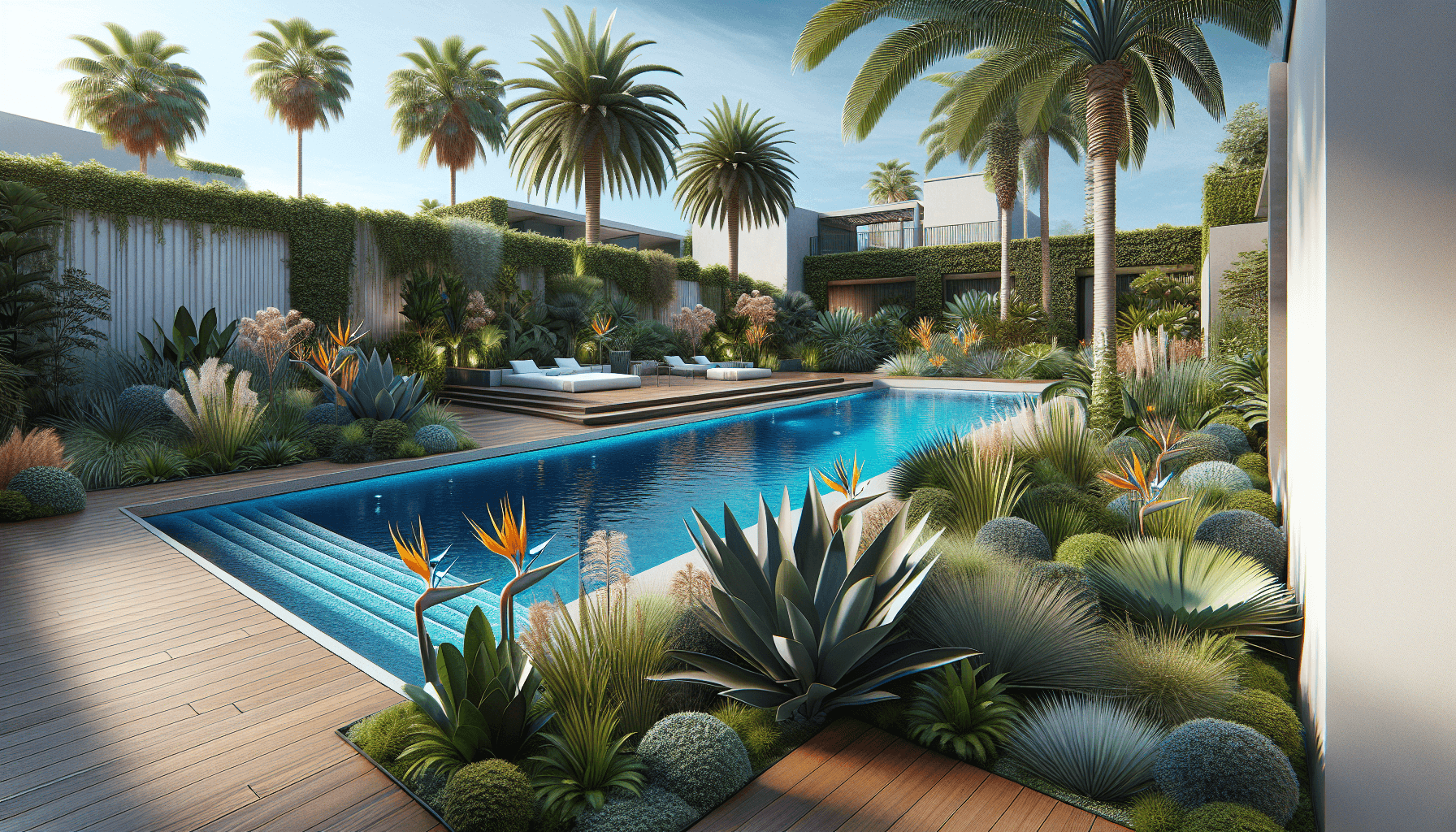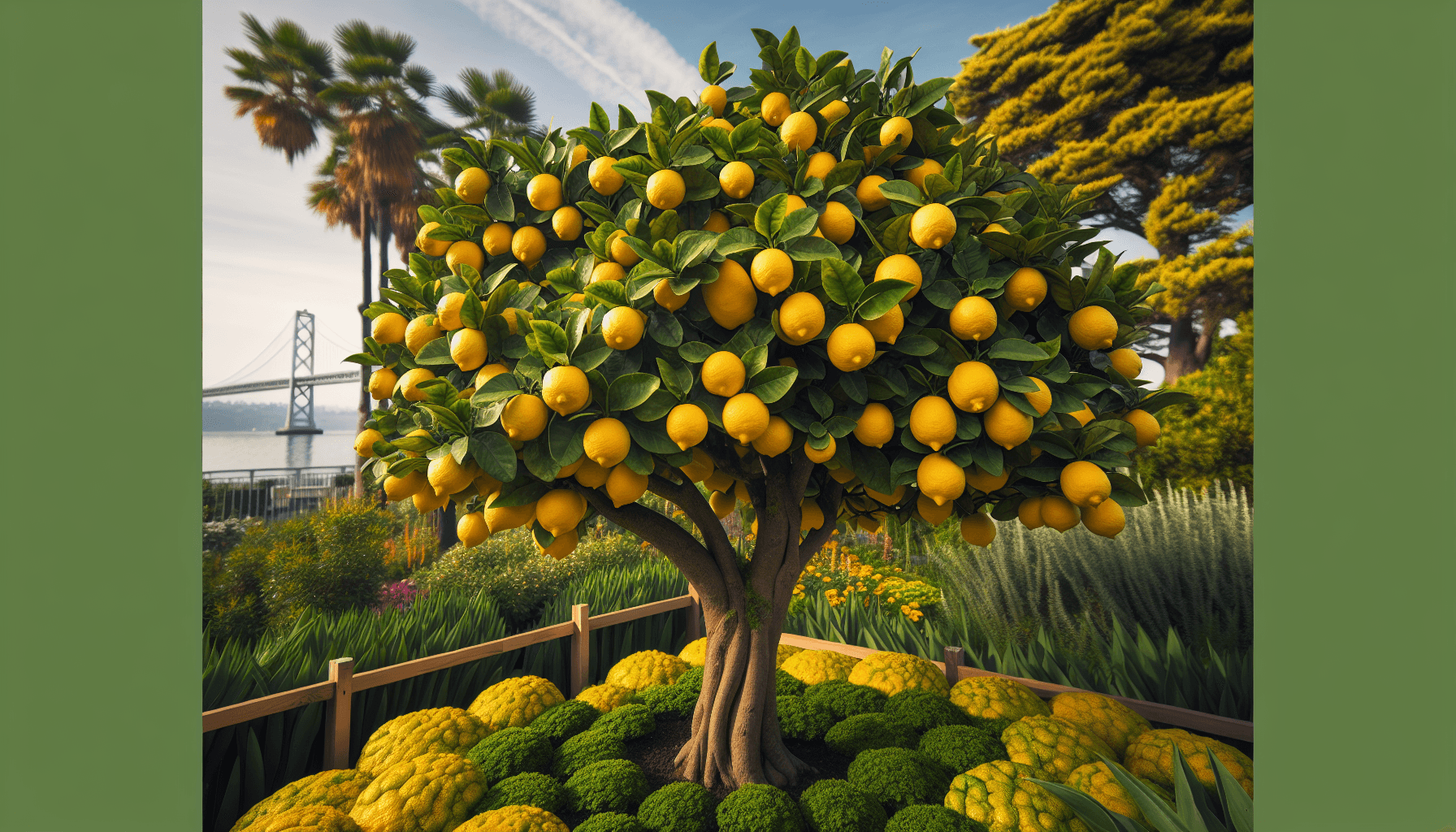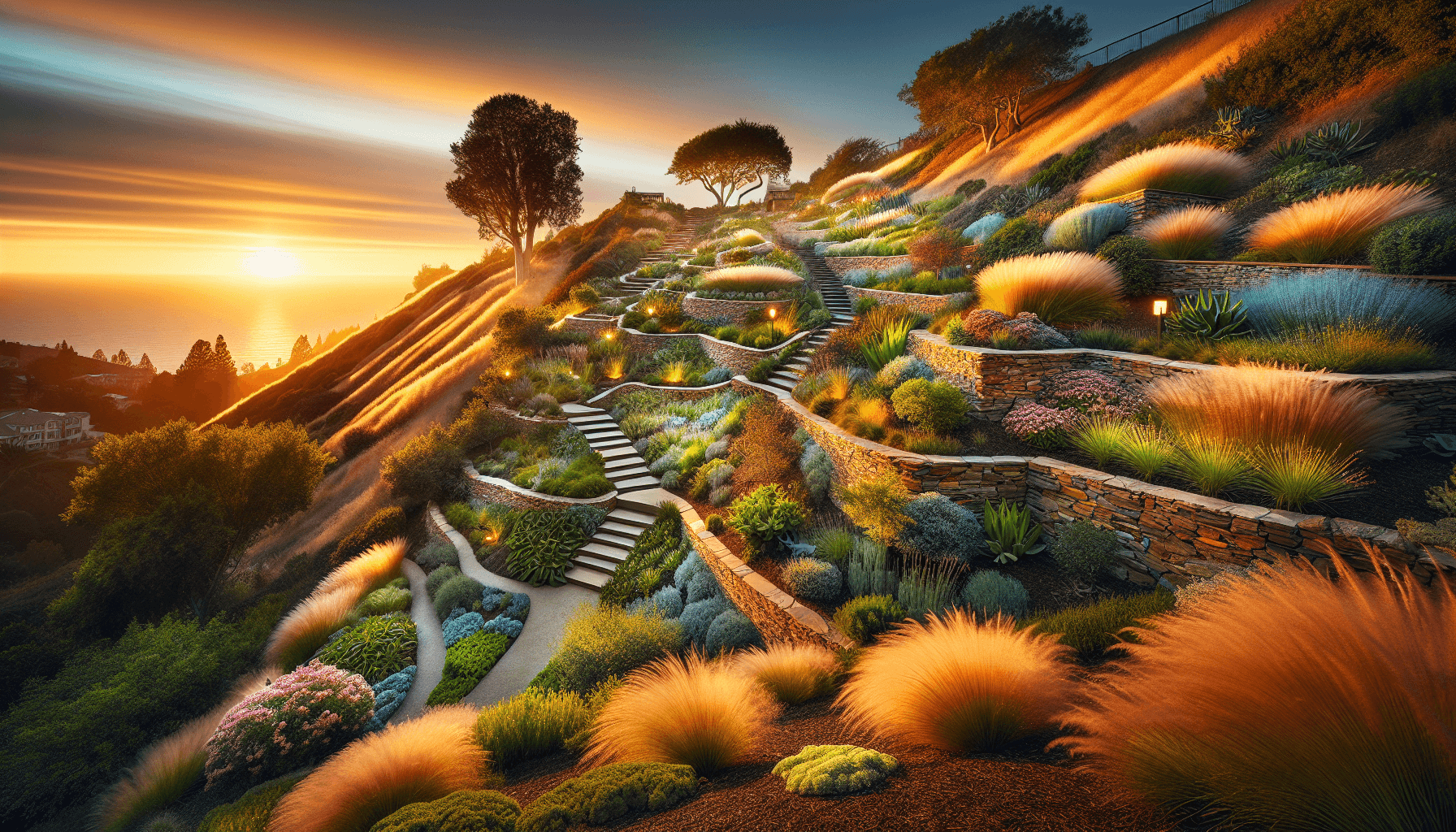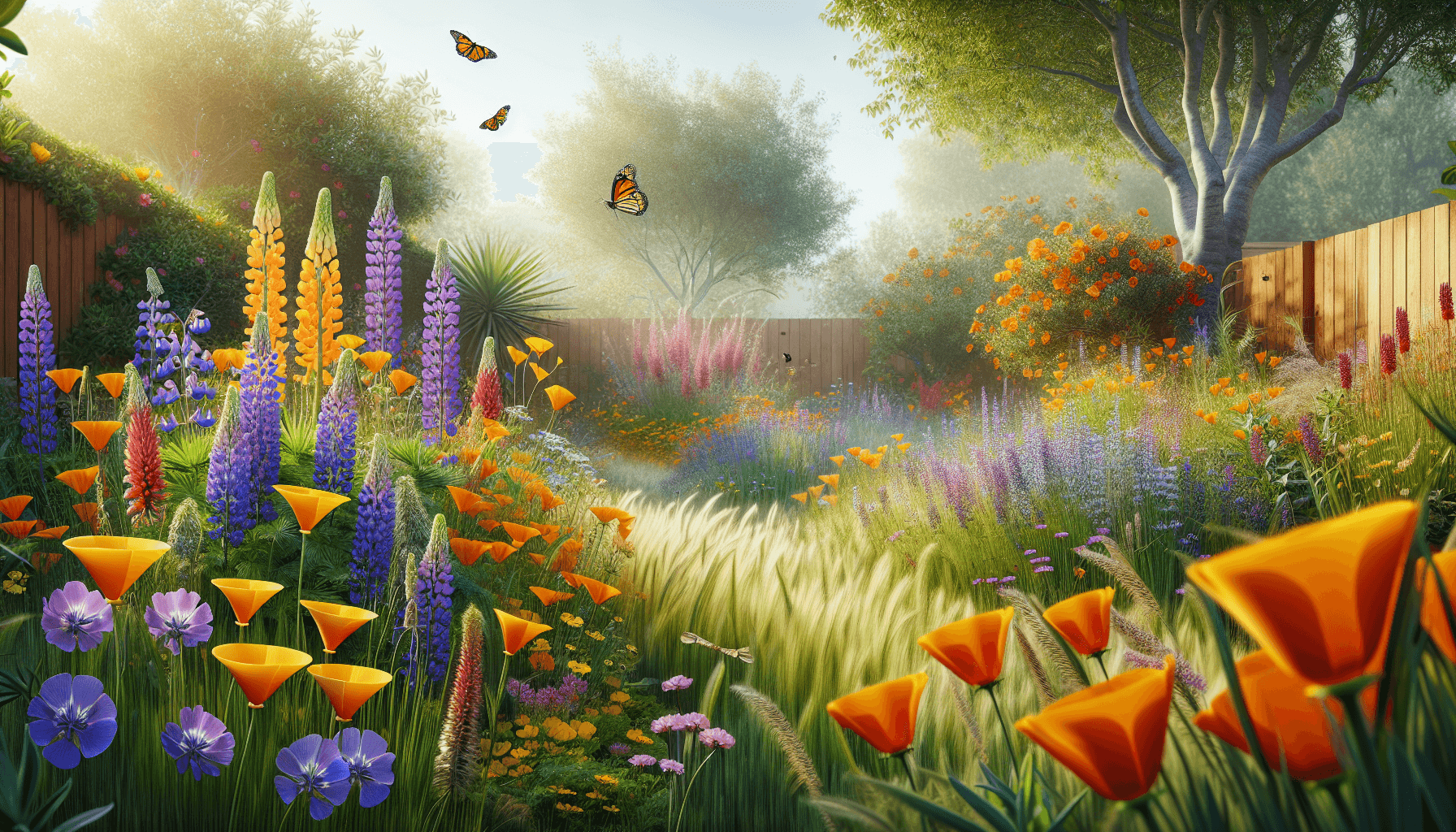There's something magical about poolside living wrapped in lush, tropical greenery. The sound of palm fronds rustling, bold foliage creating privacy, vibrant flowers adding pops of color—it transforms an ordinary backyard pool into a private resort. The best part? You can achieve this tropical aesthetic in California without the water consumption of an actual rainforest.
The secret lies in selecting plants with tropical character—oversized leaves, dramatic forms, rich colors—that are adapted to California's Mediterranean climate. With strategic plant selection and smart design, you'll create a lush poolside paradise that thrives on minimal water once established.
Why Water-Wise Tropical Works in California
The "tropical look" isn't about recreating a humid jungle—it's about capturing the feeling through strategic design choices. Several key principles make this achievable in our dry climate:
- Bold foliage over climate – Large-leaved plants create instant tropical impact regardless of their native habitat
- Drought-adapted tropicals exist – Many plants from Mediterranean climates, South Africa, and Australia offer tropical aesthetics with low water needs
- Layering creates lushness – Dense, multi-level plantings look fuller than sparse arrangements, even with fewer plants
- Strategic irrigation zones – Group true water-lovers together, keeping them separate from drought-tolerant companions
By combining these principles, you can create a poolside landscape that looks lush and tropical but uses 50-70% less water than traditional tropical plantings once established.
Plant Selection Guide
Structural Showstoppers
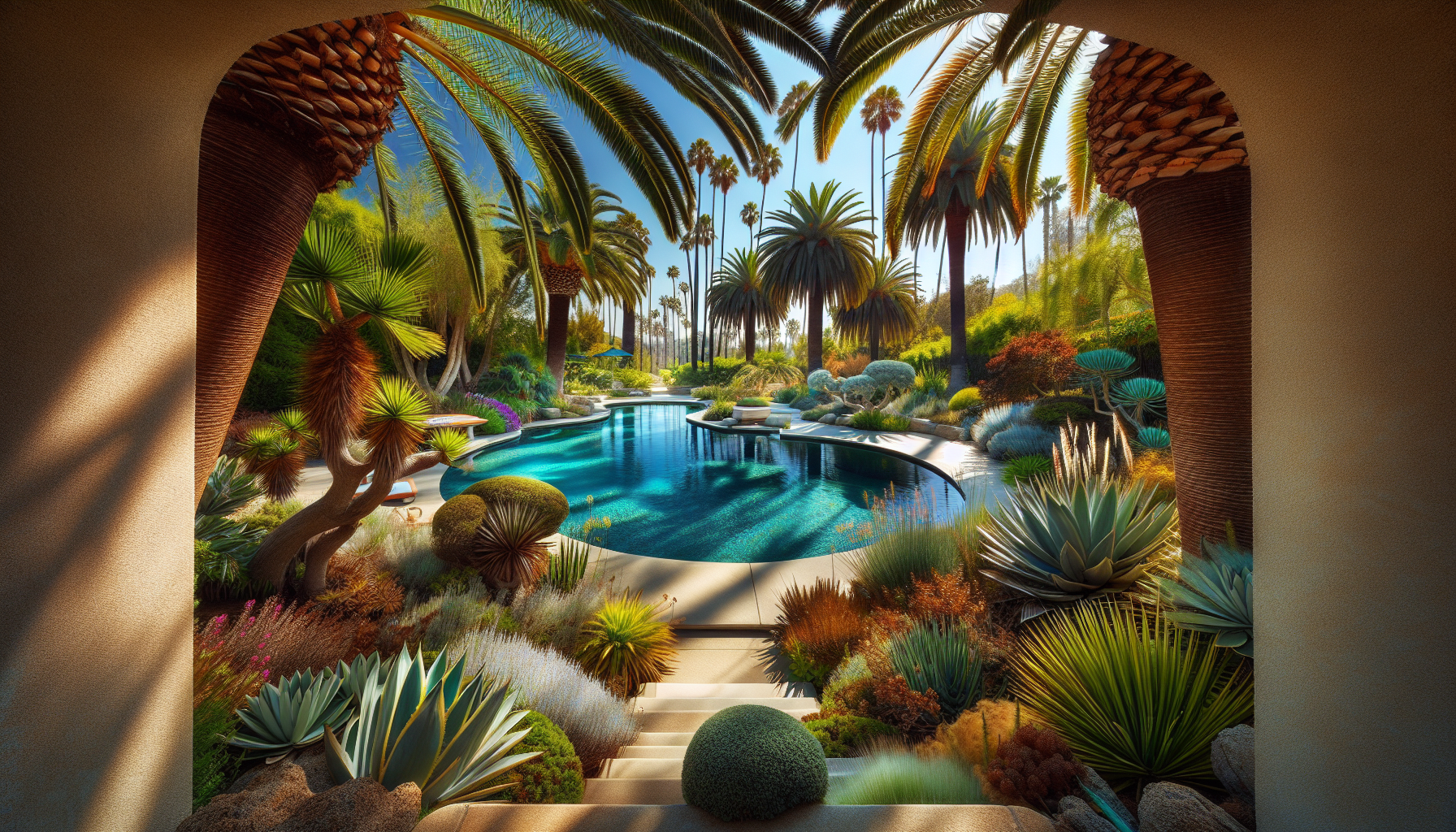
Queen palms and Mediterranean fan palms frame the pool
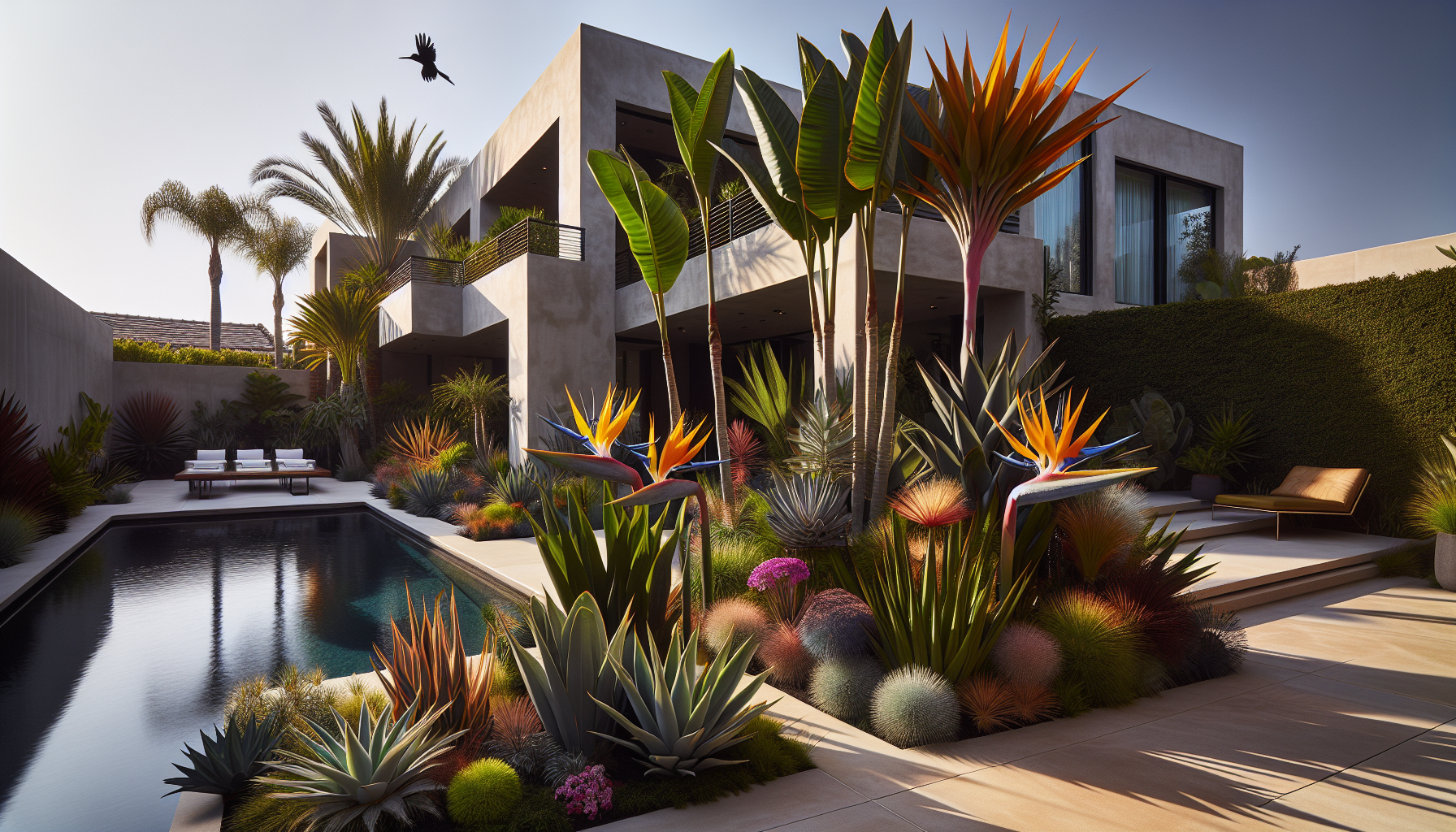
Giant bird of paradise creates dramatic architectural impact
Recommended Structural Plants
Queen Palm (Syagrus romanzoffiana)
The classic poolside palm with graceful, arching fronds. Drought-tolerant once established with deep root systems. Provides authentic tropical aesthetic with minimal maintenance.
Mediterranean Fan Palm (Chamaerops humilis)
Compact, multi-trunked palm perfect for smaller spaces. Extremely tough and drought-tolerant. Works beautifully in corners and as screening.
Giant Bird of Paradise (Strelitzia nicolai)
Massive paddle-shaped leaves create instant tropical drama. Develops architectural trunks with age. Thrives in full sun with infrequent deep watering.
Hardy Banana (Musa basjoo)
Non-fruiting banana with bold foliage that adds immediate tropical character. Fast-growing and resilient. May die back in inland winters but regrows vigorously.
Mid-Layer Drama
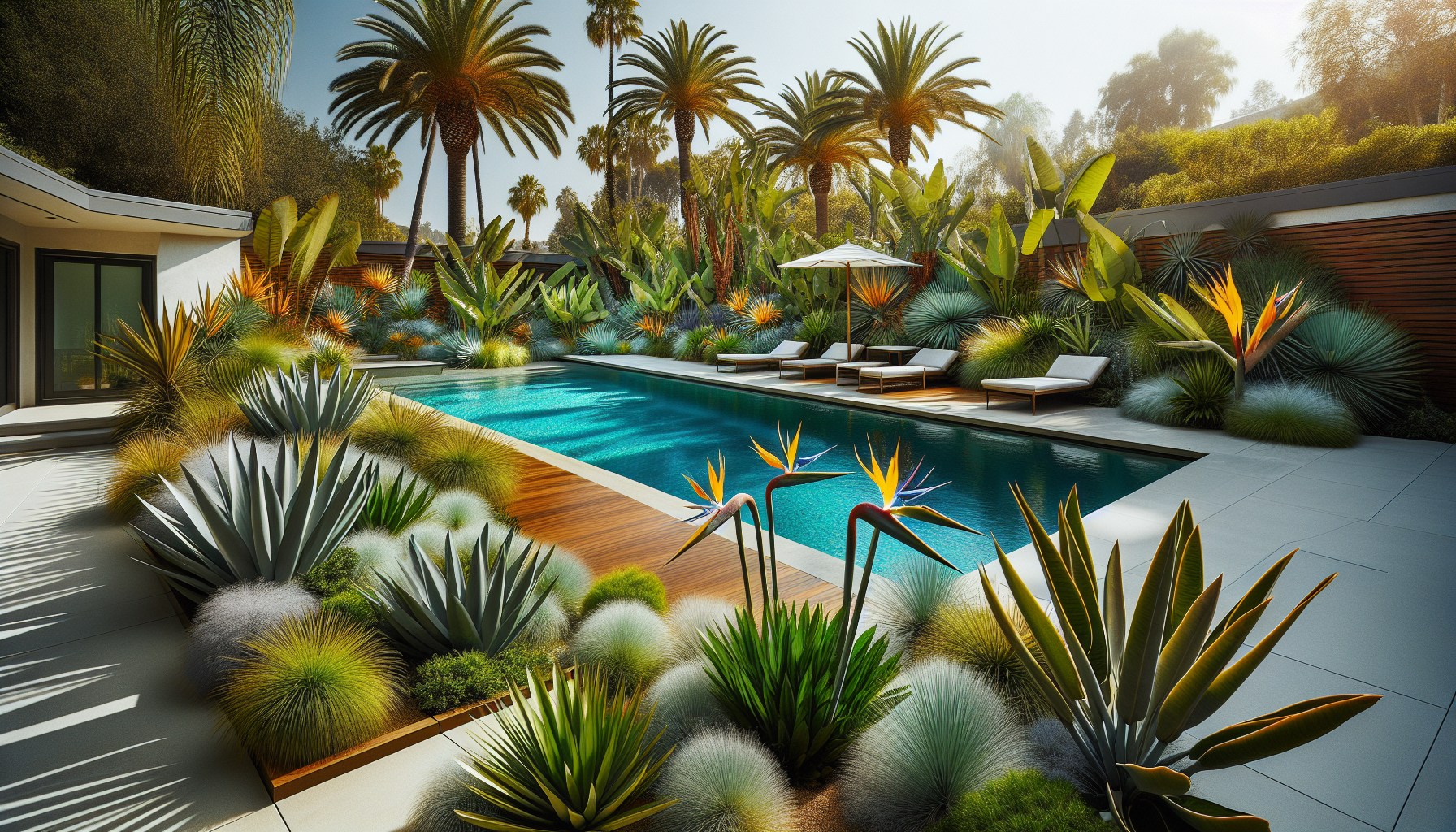
Layered plantings create depth
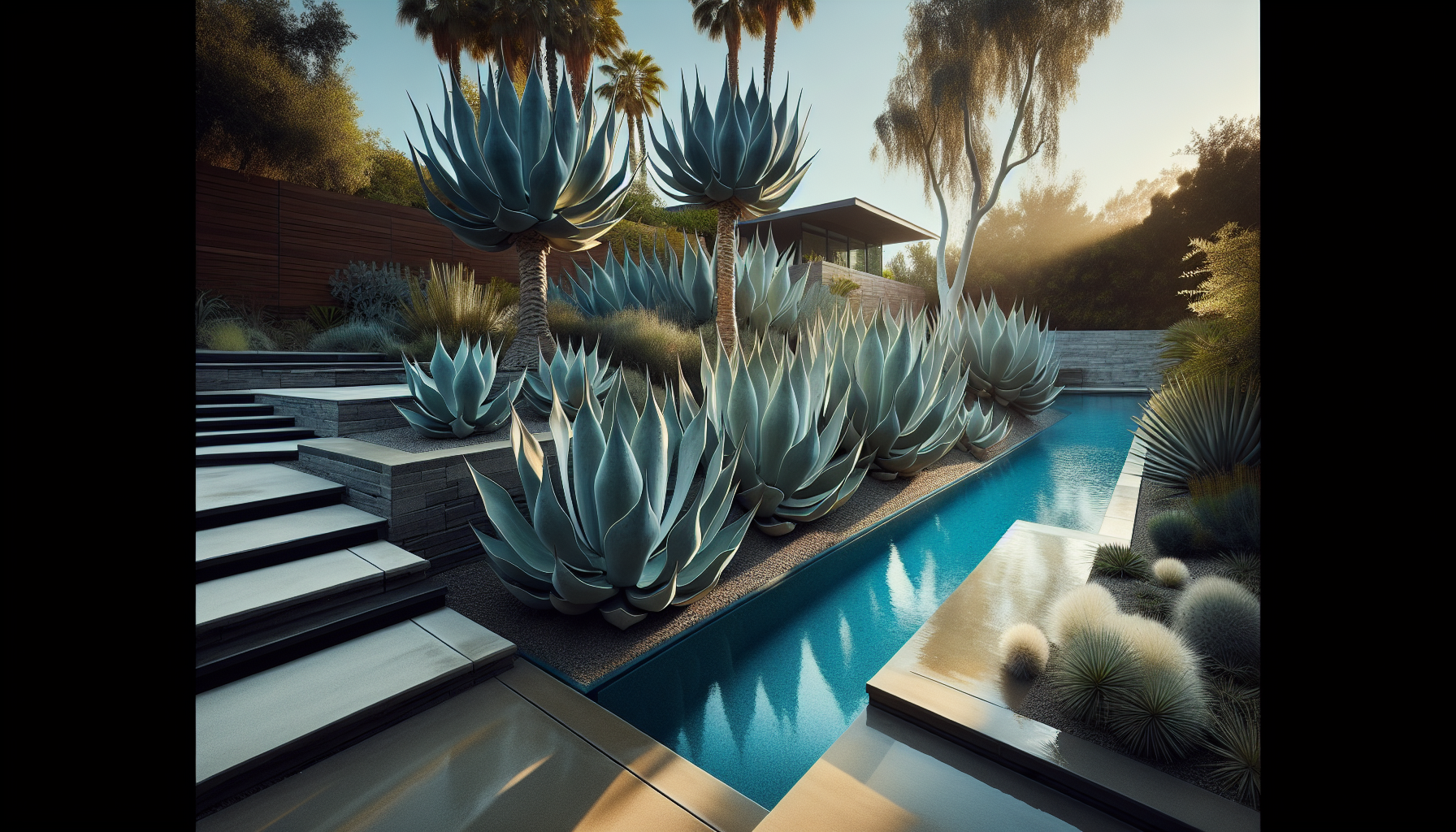
Agaves add sculptural contrast
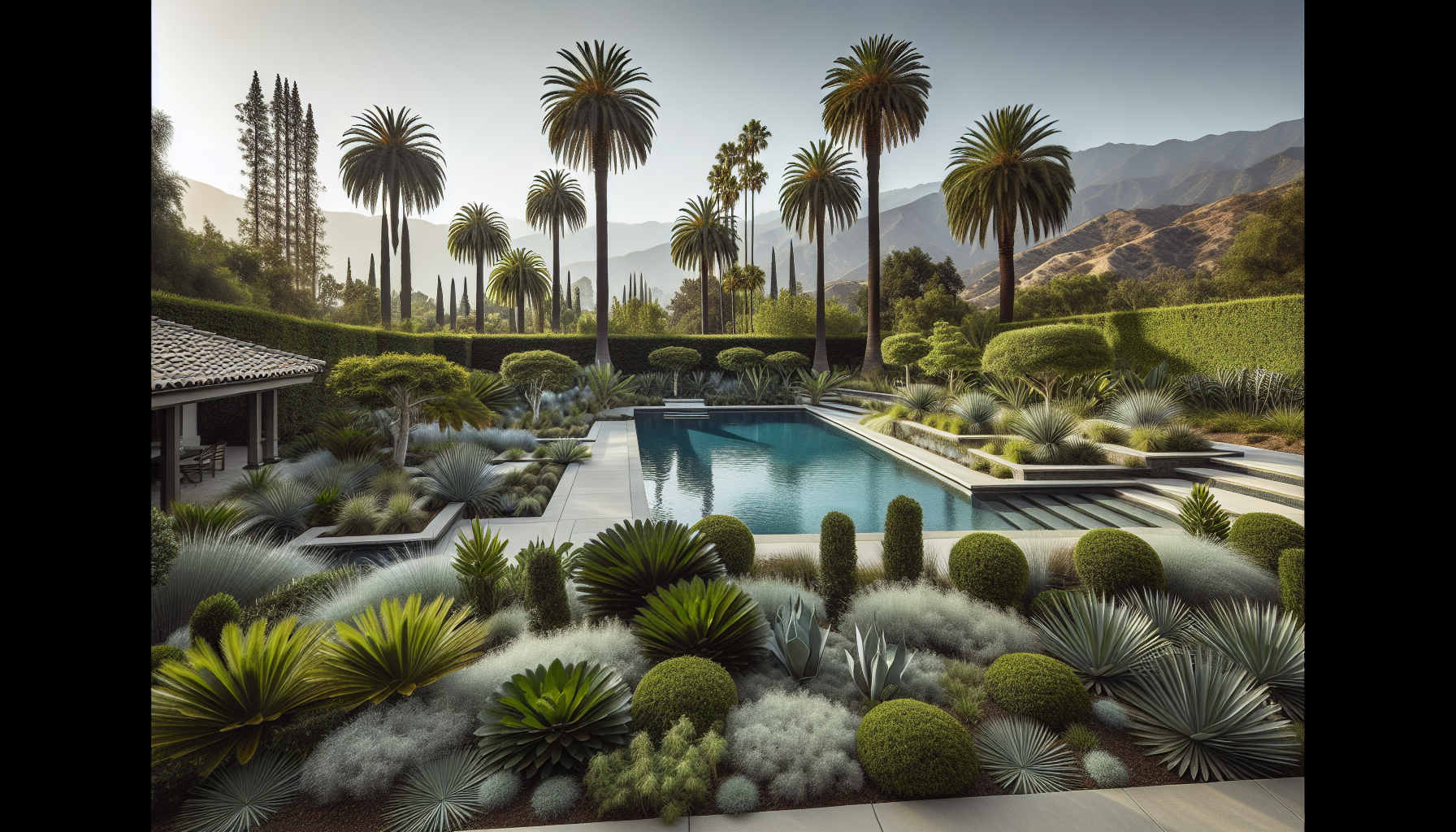
Multiple heights create lushness
Essential Mid-Layer Plants
Bird of Paradise (Strelitzia reginae)
Iconic orange and blue flowers. Compact growth habit perfect for poolside beds.
Canna Lily (Canna indica hybrids)
Bold blooms in red, orange, or yellow. Dramatic foliage adds tropical punch.
Kangaroo Paw (Anigozanthos)
Bright spikes in red, yellow, or orange. Australian native with lower water needs.
Ornamental Ginger (Hedychium)
Perfumed summer blooms. Works well in coastal or partially shaded areas.
Agave attenuata
Soft rosettes with tropical appearance. Extremely drought-tolerant.
Aloe striata (Coral Aloe)
Smooth leaves and coral flower spikes. Water-wise with year-round interest.
Groundcovers & Textural Accents
Textural Groundcovers
- Lomandra longifolia 'Breeze' - Grass-like, super tough, soft appearance at pool edge
- Agapanthus 'Peter Pan' - Compact, strappy leaves, blue summer flowers
- Clivia miniata - Shade tolerant, bold leaves, orange spring blooms
- Philodendron 'Xanadu' - Glossy leaves, lush look in shade zones
- Dymondia margaretae - Silver-green mat, walkable, drought-tolerant
Sculptural Succulents
- Agave americana - Bold architectural statements
- Aeonium arboreum - Rosette succulents, great for containers
- Aloe species - Varied sizes, colorful flower spikes
- Senecio mandraliscae - Blue chalk sticks, fine texture
- Echeveria varieties - Compact rosettes for border accents
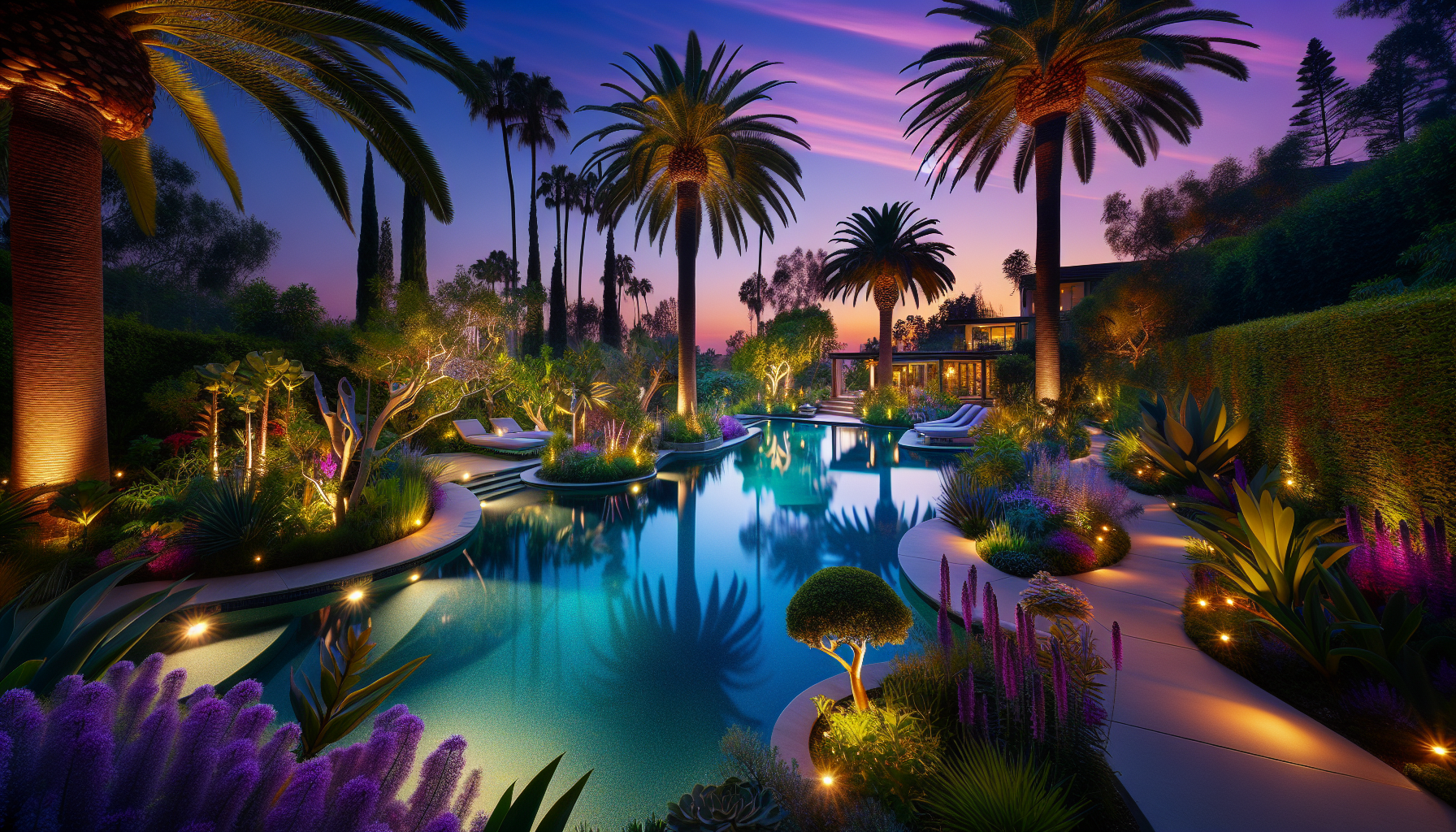
Evening lighting showcases the layered tropical plantings and creates magical atmosphere
Design Principles for Tropical Poolscapes
Layer for Lushness
Create depth by thinking vertically: tall palms and bird of paradise in the background, mid-height cannas and kangaroo paw in the middle layer, and low groundcovers like lomandra and agapanthus along the edges. This three-dimensional layering creates the sense of abundance characteristic of tropical gardens, even with water-wise plants.
Embrace Bold Foliage
The tropical aesthetic comes primarily from leaf size and shape, not moisture requirements. Prioritize plants with oversized, architectural foliage—the massive paddles of bird of paradise, the wide rosettes of agave, the dramatic fronds of palms. These create instant tropical impact regardless of their water needs.
Work with Reflections
Position your boldest plants near the water's edge to take advantage of pool reflections. Palms, bird of paradise, and upright cannas double their visual impact when mirrored in the water surface. This also helps screen pool equipment and creates privacy without solid fencing.
Zone Your Irrigation
Group plants by water needs. Place true water-lovers like cannas, gingers, and bananas together in one zone with more frequent irrigation. Keep drought-tolerant palms, agaves, and succulents in separate zones that receive deep, infrequent watering. This prevents waste while ensuring each plant thrives.
Container Strategy for Flexibility
Large containers offer incredible flexibility for tropical poolside design. They allow you to move plants seasonally, protect tender specimens from frost, and refresh your design without replanting entire beds.
Container Plant Recommendations
Large Glazed Ceramic Pots
Choose vibrant colors like turquoise, lime green, or coral for maximum tropical impact. Plant with dwarf bananas, philodendrons, or canna lilies. The bold containers become focal points even when plants aren't in peak bloom.
Lightweight Resin Planters
Modern resin containers in dark colors provide mobility without sacrificing style. Perfect for agaves, aloes, and other succulents that need repositioning to avoid winter wet.
Natural Fiber Baskets
Woven baskets or rattan planters (with waterproof liners) add organic texture. Use them for trailing plants like certain philodendrons or as seasonal displays near seating areas.
Pro Tip: Seasonal Rotation
Keep a few extra planted containers in a side yard or service area. Rotate them poolside when they're in peak bloom or at their best, swapping out specimens that need recovery time. This ensures your pool area always looks magazine-ready.
Hardscaping & Finishing Details
Hardscape choices significantly impact your tropical aesthetic. Materials, colors, and textures should enhance rather than compete with your lush plantings.
Material Recommendations
Decking
Ipe, teak, or composite decking in warm wood tones creates a resort feel. Dark colors intensify the greens of your plantings. Avoid light-colored concrete that reflects harsh glare.
Pool Coping & Paving
Natural stone in dark gray, charcoal, or warm browns complements tropical plants beautifully. Tumbled or honed finishes prevent glare and provide safe, non-slip surfaces.
Mulch & Groundcover
Use dark pebbles, basalt chips, or cocoa bean hulls for planting beds. These darker materials make greens pop visually and help retain soil moisture. Avoid light-colored gravels that create too much contrast.
Furniture & Accessories
Teak loungers, woven hanging chairs, and outdoor daybeds complete the resort atmosphere. Add bright cushions in tropical colors—turquoise, coral, lime—for punches of accent color that echo your flowering plants.
Lighting for Evening Magic
Thoughtful lighting transforms your tropical poolscape from daytime oasis to nighttime paradise. The right illumination showcases your plant selections and creates ambiance for evening entertaining.
Uplighting for Drama
Place low-voltage uplights at the base of palms and bird of paradise to cast dramatic shadows on walls or fences. This creates dimension and makes architectural plants the stars of the nighttime show.
Path Lighting for Safety
Use low-profile path lights to illuminate walkways around the pool. Choose fixtures that cast light downward rather than outward to prevent glare while ensuring safe navigation.
Accent Lighting for Atmosphere
String lights overhead, backlight water features, or use LED strips under pool coping for a soft glow. Warm white (2700K-3000K) creates a more inviting atmosphere than cool white.
Water-Wise Irrigation Strategies
Smart irrigation is the key to maintaining tropical aesthetics without tropical water bills. Zone your system by plant water needs and adjust seasonally.
Establishment Phase (Year 1)
Water deeply 2-3 times per week during the growing season. Focus on establishing deep root systems. Use drip irrigation or bubblers to deliver water directly to root zones, avoiding overspray onto pool decking.
Established Gardens (Year 2+)
Reduce to once weekly for most plants in summer, every 2-3 weeks for drought-tolerant specimens like palms and agaves. Water-loving plants like cannas and gingers may need twice weekly during peak heat.
System Design
- Install separate zones for high, medium, and low water needs
- Use drip lines or bubblers to avoid wasting water on hardscape
- Add mulch around plantings to reduce evaporation
- Install a smart controller that adjusts for weather and seasonal changes
- Consider moisture sensors to prevent overwatering
Maintenance Guide
Pruning
Remove tattered banana leaves at the base. Cut back spent canna stalks to encourage new growth. Prune palm fronds only when completely brown—never cut green fronds. Deadhead bird of paradise to promote continued blooming.
Feeding
Feed bananas, cannas, and bird of paradise with slow-release fertilizer in spring. Palms benefit from specialized palm fertilizer with magnesium and potassium once or twice annually. Succulents and agaves need minimal fertilization.
Winter Protection
Inland areas may experience frost. Cover tender plants like bananas and gingers during cold snaps, or grow them in large containers that can be moved. Coastal microclimates typically keep plantings lush year-round.
Pool Maintenance Considerations
Avoid messy fruiting plants near pools. Keep the first 3-5 feet from pool edge relatively clear for safety and easy access. Use drip irrigation rather than spray heads to prevent water from entering the pool.
Sample Layout Plans
Small Pool, Suburban Lot (Sunnyvale, Mountain View)
One queen palm in the back corner for vertical drama
Giant bird of paradise along side wall for privacy screening
Cluster of cannas and kangaroo paw in 3-foot strip bed for color
Lomandra groundcover along pool coping for soft edge
Two Agave attenuata in large white pots at patio corners
Large Pool, Hillside Property (Los Altos Hills, Saratoga)
Mediterranean fan palms and clumping bamboo as backdrop
Raised stone planter with bananas and cannas for vertical interest
Agapanthus bands along multiple pool edges for continuity
Aloe striata accents for winter bloom color
Ipe deck with teal ceramic pots of philodendrons near lounge area
Safety & Practical Considerations
Fire Safety
In fire-prone areas, maintain a 3-5 foot defensible space from pool structures using low, non-woody plants or mineral mulches. Position highly flammable species like ornamental grasses away from buildings and structures.
Pool Water Quality
Avoid messy fruiting plants near the pool that create constant skimming work. Keep irrigation systems directed at plant root zones, not pool surfaces. Use drip or bubbler systems instead of spray heads.
Access & Circulation
Ensure clear pathways to pool equipment, gates, and safety features. Avoid thorny plants like agaves near walkways and high-traffic areas. Position trailing or spreading plants where they won't encroach on circulation routes.
Chemical Tolerance
Most recommended plants tolerate occasional chlorine splash, but direct repeated contact can damage foliage. Position sensitive plants slightly back from pool edges, and use groundcovers that tolerate wet feet along immediate coping.
Getting Started
Your Tropical Poolscape Journey
-
1.
Assess Your Site
Identify sun exposure, drainage patterns, and existing hardscape. Note microclimates near the pool that may be warmer or more protected.
-
2.
Plan Your Irrigation Zones
Design separate zones for high, medium, and low water needs before planting. This prevents waste and ensures each plant receives appropriate moisture.
-
3.
Start with Structure
Plant palms and large specimens first to establish the framework. These take longest to mature and define your tropical aesthetic.
-
4.
Layer and Fill
Add mid-layer plants like bird of paradise and cannas, then groundcovers and accents. Plant in groups rather than singles for greater impact.
-
5.
Perfect Your Lighting
Install landscape lighting to showcase your plantings at night. Uplighting creates drama; path lights ensure safety and extend pool enjoyment into evening hours.
Creating a lush, tropical poolscape in California doesn't require rainforest conditions or excessive water use. With strategic plant selection—choosing species with bold foliage and tropical character that are adapted to our Mediterranean climate—you can achieve the resort aesthetic you're dreaming of while respecting our region's water resources.
By layering plants thoughtfully, zoning your irrigation intelligently, and paying attention to hardscape and lighting details, your pool area can become a private paradise that looks expensive to maintain but actually thrives on minimal care once established. Start with a strong structural framework, build in layers, and enjoy the transformation of your outdoor space into a tropical escape.
